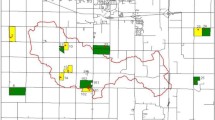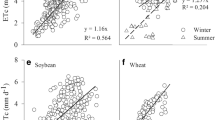Abstract
Irrigation of crops in arid regions with marginal water is expanding. Due to economic and environmental issues arising from use of low-quality water, irrigation should follow the actual crop water demands. However, direct measurements of transpiration are scant, and indirect methods are commonly applied; e.g., the Penman–Monteith (PM) equation that integrates physiological and meteorological parameters. In this study, the effects of environmental conditions on canopy resistance and water loss were experimentally characterized, and a model to calculate palm tree evapotranspiration ETc was developed. A novel addition was to integrate water salinity into the model, thus accounting for irrigation water quality as an additional factor. Palm tree ETc was affected by irrigation water salinity, and maximum values were reduced by 25 % in plants irrigated with 4 dS m−1 and by 50 % in the trees irrigated with 8 dS m−1. Results relating the responses of stomata to the environment exhibited an exponential relation between increased light intensities and stomatal conductance, a surprising positive response of stomata to high vapor pressure deficits and a decrease in conductance as water salinity increased. These findings were integrated into a modified ‘Jarvis–PM’ canopy conductance model using only meteorological and water quality inputs. The new approach produced weekly irrigation recommendations based on field water salinity (2.8 dS m−1) and climatic forecasts that led to a 20 % decrease in irrigation water use when compared with current irrigation recommendations.








Similar content being viewed by others
References
Alhammadi M, Kurup S (2012) Impact of salinity stress on date palm (Phoenix dactylifera L.)—a review. In: Sharma P, Arbol V (eds) Crop production technologies. InTech, Croatia, pp 169–178
Allen RG, Pereira LS, Raes D, Smith M (1998) Crop evapotranspiration—Guidelines for computing crop water requirements. Food and Agriculture Organization of the United Nations (FAO), Rome
Avissar R, Avissar P, Mahrer Y, Bravdo BA (1985) A model to simulate response of plant stomata to environmental conditions. Agric For Meteorol 34:21–29
Ben-Gal A, Shani U (2002) A highly conductive drainage extension to control the lower boundary condition of lysimeters. Plant Soil 239:9–17
Ben-Gal A, Ityel E, Dudley L, Cohen S, Yermiyahu U, Presnov E, Zigmond L, Shani U (2008) Effect of irrigation water salinity on transpiration and on leaching requirements: a case study for bell peppers. Agric Water Manag 95:587–597
Bhantana P, Lazarovitch N (2010) Evapotranspiration, crop coefficient and growth of two young pomegranate (Punica granatum L.) varieties under salt stress. Agric Water Manag 97:715–722
Boulard T, Wang S (2000) Greenhouse crop transpiration simulation from external climate conditions. Agric For Meteorol 100:25–34
Collatz GJ, Ball T, Grivet C, Berry JA, Meteorology F (1991) Physiological and environmental regulation of stomatal conductance, photosynthesis and transpiration: a model that includes a laminar boundary layer. Agric For Meteorol 54:107–136
Corley R, Hardon J, Tan G (1971) Analysis of growth of the oil palm (Elaeis guineensis Jacq.) I. Estimation of growth parameters and application in breeding. Euphytica 20:307–315
Damour G, Simonneau T, Cochard H, Urban L (2010) An overview of models of stomatal conductance at the leaf level. Plant, Cell Environ 33:1419–1438
Downton WJS, Loveys BR, Grant WJR (1990) Salinity effects on the stomatal behaviour of grapevine. New Phytol 116:499–503
Gerosa G, Mereu S, Finco A, Marzuoli R, Cuore S (2012) Stomatal conductance modeling to estimate the evapotranspiration of natural and agricultural ecosystems. In: Irmak A (ed) Evapotranspiration—remote sensing model. InTech, Croatia, pp 403–420
Gowing J, Ejieji C (2001) Real-time scheduling of supplemental irrigation for potatoes using a decision model and short-term weather forecasts. Agric Water Manag 47:137–153
Granier A, Loustau D, Bréda N (2000) A generic model of forest canopy conductance dependent on climate, soil water availability and leaf area index. Ann For Sci 57:755–765
Gutschick VP, Simonneau T (2002) Modelling stomatal conductance of field-grown sunflower under varying soil water content and leaf environment: comparison of three models of stomatal response to leaf environment and coupling with an abscisic acid-based model of stomatal response to soil drying. Plant, Cell Environ 25:1423–1434
Hogan K (1988) Photosynthesis in two neotropical palm species. Funct Ecol 2:371–377
Jarvis PG (1976) The interpretation of the variations in leaf water potential and stomatal conductance found in canopies in the field. Philos Trans R Soc London B Biol Sci 273:593–610
Letey J, Dinar A, Knapp K (1985) Crop-water production function model for saline irrigation waters. Soil Sci Soc Am J 49:1005–1009
Li Yang S, Yano T, Aydin M, Kitamura Y, Takeuchi S (2002) Short term effects of saline irrigation on evapotranspiration from lysimeter-grown citrus trees. Agric Water Manag 56:131–141
Liu F, Andersen MN, Jensen CR (2009) Capability of the “Ball–Berry” model for predicting stomatal conductance and water use efficiency of potato leaves under different irrigation regimes. Sci Hortic (Amst) 122:346–354
Lovelli S, Perniola M, Ferrara A, Di Tommaso T (2007) Yield response factor to water (Ky) and water use efficiency of Carthamus tinctorius L. and Solanum melongena L. Agric Water Manag 92:73–80
Maas EV, Hoffman GJ (1977) Crop salt tolerance—current assessment. J Irrig Drain Div 103:115–134
Meiri A, Kamburov J, Shalhevet J (1977) Transpiration effects on leaching fractions. Agron J 69:779–782
Monteith JL (1965) Evaporation and environment. Symp Soc Exp Biol 19:205–234
Rana G, Katerji N (1998) A measurement based sensitivity analysis of the Penman–Monteith actual evapotranspiration model for crops of different height and in contrasting water status. Theor Appl Climatol 149:141–149
Rana G, Katerji N (2000) Measurement and estimation of actual evapotranspiration in the field under Mediterranean climate: a review. Eur J Agron 13:125–153
Roupsard O, Bonnefond JM, Irvine M, Berbigier P, Nouvellon Y, Dauzat J, Taga S, Hamel O, Jourdan C, Saint-Andre L, Mialet-Serra I, Labouisse JP, Epron D, Joffre R, Braconnier S, Rouziere A, Navarro M, Bouillet JP (2006) Partitioning energy and evapo-transpiration above and below a tropical palm canopy. Agric For Meteorol 139:252–268
Shani U, Dudley L (2001) Field studies of crop response to water and salt stress. Soil Sci Soc Am J 65:1522–1528
Shuttleworth W, Wallace J (1985) Evaporation from sparse crops—an energy combination theory. Q J R Meteorol Soc 111:839–855
Smith BG (1989) The effects of soil water and atmospheric vapour pressure deficit on stomatal behaviour and photosynthesis in the oil palm. J Exp Bot 40:647–651
Sperling O, Shapira O, Cohen S, Tripler E, Schwartz A, Lazarovitch N (2012) Estimating sap flux densities in date palm trees using the heat dissipation method and weighing lysimeters. Tree Physiol 32:1171–1178
Sperling O, Lazarovitch N, Schwartz A, Shapira O (2014) Effects of high salinity irrigation on growth, gas-exchange, and photoprotection in date palms (Phoenix dactylifera L., cv. Medjool). Environ Exp Bot 99:100–109
Stanghellini C, Bosma AH, Gabriels PCG, Werhoven C (1989) The water consumption of agricultural crops: how crop coefficients are affected by crop geometry and microclimate. Symp Sched Irrig Veg Crop Field Cond 278:509–516
Stannard D (1993) Comparison of Penman–Monteith, Shuttleworth–Wallace, and modified Priestley–Taylor evapotranspiration models for wildland vegetation in semiarid range land. Water Resour Res 29:1379–1392
Stewart JB (1988) Modelling surface conductance of pine forest. Agric For Meteorol 43:19–35
Tattini M, Gucci R, Coradeschi MA, Ponzio C, Everard JD (1995) Growth, gas exchange and ion content in Olea europaea plants during salinity stress and subsequent relief. Physiol Plant 95:203–210
Tripler E, Shani U, Mualem Y, Ben-Gal A (2011) Long-term growth, water consumption and yield of date palm as a function of salinity. Agric Water Manag 99:128–134
Wallace JS, Roberts JM, Sivakumar MVK (1990) The estimation of transpiration from sparse dryland millet using stomatal conductance and vegetation area indices. Agric For Meteorol 51:35–49
Wilks DS, Wolfe DW (1998) Optimal use and economic value of weather forecasts for lettuce irrigation in a humid climate. Agric For Meteorol 89:115–129
Acknowledgments
This project was partially supported by I-CORE Program of the Planning and Budgeting Committee and the Israel Science Foundation (Grant No. 152/11), by a grant (No. 704-0002-09) from the Chief Scientist of the Israeli Ministry of Agriculture, and through support provided by the Rosenzweig-Coopersmith Foundation and by ICA in Israel.
Author information
Authors and Affiliations
Corresponding authors
Additional information
Communicated by E. Fereres.
Rights and permissions
About this article
Cite this article
Sperling, O., Shapira, O., Tripler, E. et al. A model for computing date palm water requirements as affected by salinity. Irrig Sci 32, 341–350 (2014). https://doi.org/10.1007/s00271-014-0433-5
Received:
Accepted:
Published:
Issue Date:
DOI: https://doi.org/10.1007/s00271-014-0433-5




